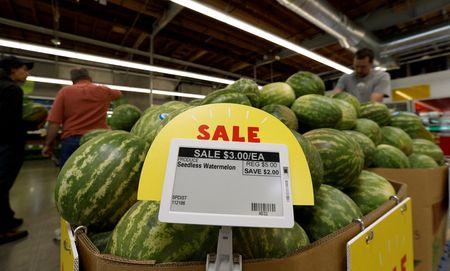By Howard Schneider
WASHINGTON (Reuters) – A measure of inflation closely watched by the Federal Reserve has now averaged near the central bank’s 2% target for the last three months, another step forward in the Fed’s inflation battle and a sign that price increases have continued slowing despite better-than-expected job and economic growth.
Stripped of food and energy costs that Fed officials view as less indicative of underlying price trends, the “core” personal consumption expenditures price index rose just 0.1% in August, a 1.2% annual rate, and for the last three months has averaged right at the Fed’s target, government data on Friday showed.
A separate “supercore” index, which measures services excluding energy and the housing costs that Fed officials are convinced are in for a sustained decline, also rose just 0.1% in August versus 0.5% in July – evidence that sustained inflation in important parts of the service industry, a concern of Fed officials for months, may be moderating.
It was a number welcomed by the Biden administration, whose management of the economy through the pandemic and subsequent outbreak of inflation, will likely be central to next year’s presidential campaign.
“The main story of all the naysayers was that you couldn’t get core inflation to come down without a big increase in job destruction. That is not what we’ve seen,” said Lael Brainard, director of the National Economic Council and a former vice chair of the Fed. “We’ve seen continued job creation and inflation at the core has come down into the range we saw pre-pandemic.”
The U.S. unemployment rate has been in a range of 3.4% to 3.8%, low by historical standards, since March of 2022, the month the Fed began a series of fast, inflation-fighting interest rate increases that was expected by many to lead to a recession and rising joblessness.
With a possible U.S. government shutdown beginning this weekend, the release on Friday could be among the last major data points the Fed has in hand for its Oct. 31 – Nov. 1 meeting – should the stalemate in the U.S. Congress over a spending bill last that long.
The Fed, which is self-funded, would continue operating even if the rest of the government does not. But despite its in-house expertise and ability to estimate what the economy is doing, the central bank relies heavily on official government data that would be put on hold if workers are told to stay home – including a jobs report due next Friday.
On its own, the PCE release left traders discounting the likelihood that the Fed will follow through with any further rate increases, despite projections issued at the Fed’s most recent meeting showing a majority of officials expect to raise the benchmark policy rate by another quarter point by the end of the year.
Given how month-to month-data are evolving, inflation by year’s end may be well below the projections given by Fed officials just two weeks ago, when policymakers at the median anticipated core PCE would end the year at 3.7%, said Omair Sharif, president of Inflation Insights.
“Core inflation is likely to comfortably undershoot the Fed’s 3.7% projection,” perhaps ending the year as low as 3.3%, he wrote in an analysis after the latest PCE data were released. “Unless you have a sustained reacceleration penciled in for the core PCE it will be tough to see the Fed hit their estimate.”
In August, core PCE was up 3.9% from the year-earlier month, compared with 4.3% in July.
That outcome, if affirmed in coming months, would likely lead the Fed to hold rates steady again at its Oct. 31-Nov. 1 meeting, as it did last week.
In remarks on Friday, John Williams, leader of the New York Fed and vice chairman of the rate-setting Federal Open Market Committee, said that while inflation remains too high it’s cooling off and is on track to hit 2% by 2025. He also suggested the Fed may be done with rate increases.
“My current assessment is that we are at, or near, the peak level of the target range for the federal funds rate,” Williams said in a speech text. “I expect we will need to maintain a restrictive stance of monetary policy for some time to fully restore balance to demand and supply and bring inflation back to desired levels.”
The data could also bolster the case, emphasized more forcefully by some Fed officials in recent weeks, that the U.S. may escape this bout of inflation without the sort of serious downturn or rise in unemployment that has accompanied past inflation battles.
Recent jobs data also showed important aspects of the labor market, such as the hiring and quits rates, beginning to behave as they did before the pandemic, a return to normal that Fed officials believe will help moderate price and wage increases.
“The Fed has the chance to achieve something quite rare in the history of central banks — to defeat inflation without tanking the economy,” Chicago Fed President Austan Goolsbee said on Thursday.
(Reporting by Howard Schneider; Additional reporting by Ann Saphir and Michael S. Derby; Editing by Andrea Ricci)

